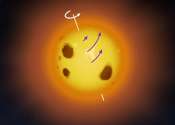A new telescope probes a young protostar
(Phys.org) —IRAS 16293-2922B is a very young star – a protostar - perhaps only about ten thousand years old. Slightly smaller in mass than our Sun, it is still deeply embedded in its surrounding natal material, and apparently ...









